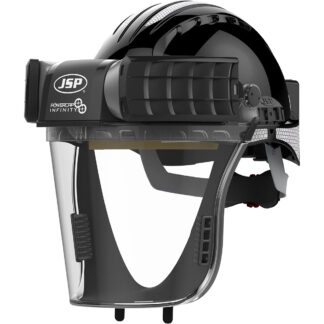Respiratory protective equipment (RPE) is crucial for anyone working in an environment exposed to harmful chemicals or substances. The wearer needs to be protected from contaminated air at all times and poor fitting RPE is a common cause of leakages.
People have different face shapes and sizes, so a one-size-fits-all approach is ineffective with RPE. This is where a face-fitting test is vital. Face fit tests are an ideal way to ensure the equipment is suitable for the wearer and provides the necessary protection.
What is face fit testing?
Face fit testing is designed to ensure that a facepiece, respirator or mask fits the wearer’s face securely, providing an effective seal. Without a proper seal, contaminants could enter the mask and put the wearer at risk. This test ensures that the mask forms a reliable barrier against harmful particles, protecting the wearer’s health.
Is it a legal requirement to have a face fit test?
Yes, face fit testing is a legal requirement for anyone who wears a tight-fitting mask for work. The Control of Substances Hazardous to Health (COSHH) Regulations 2002 states that workers who require a respirator need a face fit test and accompanying training on how to use it properly. Employers are responsible for providing suitable fit testing and clear instructions on how to use the protective equipment.
Who can carry out a face fit test?
The HSE states that fit tests must be carried out by a competent person which can be demonstrated by acquiring an accreditation under the Fit2Fit RPE Fit Test Providers
Accreditation Scheme. This scheme was developed by the BSIF, alongside industry stakeholders, and is supported by HSE. It is not a compulsory scheme, and fit testers can prove their competency by having adequate knowledge and training in RPE also.
How long does the face fit test certificate last?
It is recommended to repeat the face test between 1-2 years, or sooner if someone has experienced any facial injuries, substantial weight loss or any other changes in their facial features.
It’s important to note that the fit testing is only valid for the specific mask that you were fitted with. If you need to use a different make or style of mask another fit test will be required.
Do you have to shave for a face fit test?
Shaving is generally required for a face fit test, as facial hair can cause gaps around the edges of the mask that prevents a tight seal against the skin. For accurate test results, it’s advised to be clean-shaven, removing stubble and beards, to prevent any leakage of contaminated air.
What to expect when having a face fit test?
There are two different types of face fit tests, qualitative and quantitative. Both methods aim to make sure the mask or respirator has an adequate seal to the wearer’s face, but using different techniques and tools.
Qualitative fit test: This test involves detecting a specific smell. The wearer puts the mask/respirator on and places a hood over their head. A bitter or sweet solution (Bitrex or saccharin) is introduced into the hood. The wearer then carries out a variety of movements to mimic normal working conditions. If the wearer can detect the solution, the fit is not adequate and needs to be reconsidered. This method is generally used for half-mask respirators that cover the nose and mouth.
Quantitative fit test: This test checks the quality of the seal by measuring the amount of particles that have leaked into the mask. The mask/respirator is connected to a machine that evaluates the particle levels in the room and inside the mask, calculating a fit factor based on the ratio of these measurements. The wearer performs movements that mimic normal working conditions during the test. This method is suitable for both half-mask and full-face respirators.
Can you fail a face fit test?
Yes, you can fail a fit test due to the mask not forming a proper seal with the face, which allows potential contaminants to enter.
Some common reasons for not forming a proper seal are:
- Facial hair
- Incorrect mask size or type
- Poor mask position or fitting technique
If you fail a fit test, it is essential to uncover why and address the issue immediately. It can take a few tests before finding the right fit. However, if after two fit tests the result is still a fail, another size or type of facepiece should be tried.
Ensure your workplace safety
Anyone who is required to wear a mask or respirator in the workplace must undergo a face fit test. It is important to make sure the mask fits accurately and provides protection from harmful chemicals and substances. Both workers and employers should have a thorough understanding of the process and requirements that need to be put in place. At Dust Masks Direct, we offer a wide range of masks and respirators, as well as face fit testing products and kits. For more information give us a call on 01842 765634 to speak to our team about your options.




